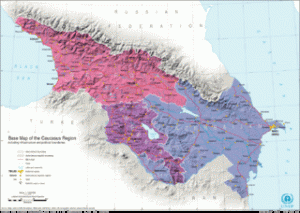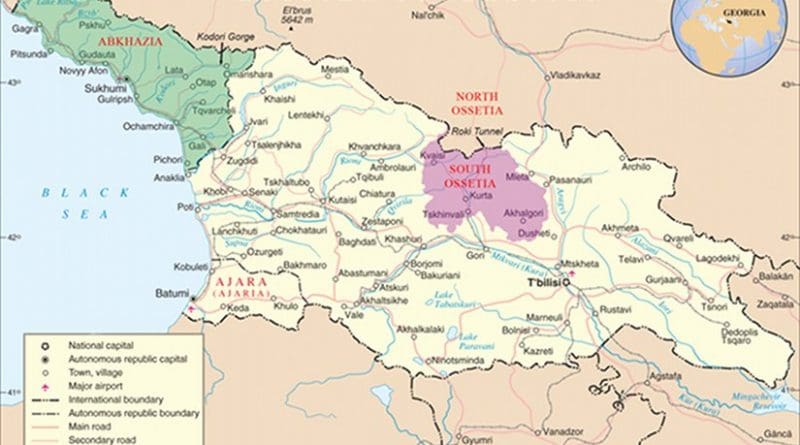Caucasus: A Maelstrom Of Geography
While fighting raged in South Ossetia between Georgian and Russian forces in August 2008, the Drudge Report, the popular US-based news aggregator, posted one of its customarily colorful headlines on the escalating Caucasus conflict. “The Pipeline War,” it announced to its millions of daily readers, linking to a similarly-sensationalist Daily Mail report of the same headline. [1]
Drudge and the Daily Mail, two media outlets with a solid reputation for a history of unabashed melodramatics, did their best to frame a complicated issue within the context of a catchy headline within Twitter-sized parameters. For them, the geopolitics was easy: Russia’s war with Georgia was part of a larger energy gambit to monopolize the flow of hydrocarbons to Europe, affording the Kremlin key leverage in European capitals.
It’s a compelling argument, to be sure, and one that is elegantly simple and easily explainable to a wide audience. It also has the benefit of containing a not insignificant amount of evidence to support the idea; [2] Russia itself has not been shy about linking its energy policies to the wider affairs of statecraft. Abrupt embargoes, stoppages, and suspicious mechanical problems that disrupt supply to ‘problem’ countries have been something of a hallmark of Russia’s record as an energy supplier to its near abroad.
Nonetheless, the ‘pipeline war’ moniker never stuck. Despite the neat and forceful narrative that the headline implied, the inherent complexity of both Russia’s larger geopolitical ambitions and the 2008 war’s raison d’être have proven thus far to be too much for the historians and pundits to easily categorize. Today, in a gesture underlining the war’s complicated and controversial origins, most writers refer to the conflict event as either the ‘South Ossetia war’ or the ‘August war’ or some other generic variant thereof.
When the EU-commissioned Tagliavini report came out in 2009, many hoped that the document would settle lingering questions and put the facts to rest so that global affairs could nod and move on. And though it’s achieved that to some degree, the Tagliavini report, for all of its comprehensive i-dotting and t-crossing, also became everything to everyone. For Russia, it was definitive proof that it was the Georgians that fired the first shot. For Georgia, it substantiated their allegations of a long-term narrative of Russian aggression. And in the West, and particularly the NATO member states, it was enough of a full-spectrum blame game that they could call the whole thing off and get back to the business of taking advantage of Dmitry ‘the modernizer’ Medvedev’s presidency to securing Moscow’s assistance in Afghanistan, Iran, and elsewhere.

But the one constituency that Swiss veteran diplomat Heidi Tagliavini failed to answer to in her extensive report was the journalists. True, Ms. Tagliavini had neither the obligation nor even necessarily the mandate to provide the kind of sound bites and one-liners that the media desperately sought from her encyclopedic expanse of research. Predictably, the industry acted accordingly and seemingly contradictory pieces emerged from the report’s release, each seeking to fit the three-volume report into a conclusion of 500 to 1000 words but coming up woefully short.
The reality of the matter is that the report’s scope (and predictably, its conclusions) was simply too extensive to boil down into an AP stringer’s summary upon which everyone could more or less agree. It was complicated because the war was complicated, and the war was complicated because the situation in the Caucasus is — surprise! — complicated.
But this is not an answer; and scholars, policy professionals, journalists, or even the average citizen can and should not be contented with this kind of response. Even if we can’t cram the gristle of the entire geostrategic context into an easily digestible appellation, that doesn’t mean that we shouldn’t try to create the rudiments of a narrative from which to work.
To begin, we needn’t look at the Kremlin, or Washington, or even Tbilisi. First, the key to considering the questions of the region is the region itself. What is it about the Caucasus that makes it so prone to the tectonics of great power collisions? What is it about the Caucasus that makes it so prone to the tectonics of great power collisions?
In many parts of the world, ‘strategic’ regions are only so because they are assigned value by supposedly important people who say so. Now, that doesn’t necessarily mean that these places do not hold strategic value — strategic value is only a construct, after all — but it does mean that if certain actors changed, the possibility of those places’ importance very well could diminish as well. The Caucasus, however, shares no part of such a blessing. Its position and reputation as a transcontinental high ground has survived for centuries intact; more tellingly, the question of its strategic value has endured even into the jet and internet age, well after the moment when the crags and boulders of the mountains lost much of their inherent defensibility.
That’s because it’s probably never been just the highland topography that boosted the region’s strategic stock price, but a more fundamental geographic reality: its position as a frontier zone. Even excluding the question of human settlement, the Caucasus region has never been a particularly hospitable place as an agricultural breadbasket. While exceptional growing regions do exist, they are relatively sparse compared to the steppes to the north and east and the vast, fertile growing regions of Anatolia and Mesapotamia to the south. And while rich cultures have historically flourished in the Caucasus — particularly in Georgia, which is the most agriculturally suitable area — they have been nonetheless constrained by environmental limitations. It’s also no coincidence that the fonts of the regional great powers have been to the north and south of the Caucasus — both being areas of extensive agricultural potential.
The Caucasus straddles that buffer zone between the central Eurasian great powers, where it forms both a geographical and a cultural bottleneck of influence radiating in both directions. Gaining control of the Caucasus, or disrupting it, has been a historical priority for the local powers to build on the region’s natural bulwark of mountains, hills, forests, and rivers while taking a commanding posture over transportation and trade.
In the 21st century, the strategic significance of mountaintop lookouts has obviously lessened somewhat, but the same dynamics that shaped the historical encounters between the big countries and adjoining continents is still a force today. The cultural ecology that helped nurture the roots of the region’s major players — Turkey, Russia, and Iran (and occasionally joined by others) — means that the Caucasus remains valuable real estate where their interests converge.
As a frontier zone, it has also never been fully absorbed as a full-time member in any of the historical empires. Despite efforts to transform chunks of the Caucasus into imperial provinces, the inertia of cultural ecology and the presence of the region as a borderland meant that the Caucasus satrapies, oblasts, and emirates rarely became much more than highly glorified tributaries and colonies. This doesn’t mean that enculturation or diffusion didn’t occur between imperial representatives and their subjects, sometimes with permanent effect, but it does mean that the wholesale sway that these powers exercised over their Caucasus dominions typically lasted only as long as their troops did.
Of course, the main problem with this model of central Eurasia is that it seems to nod towards a kind of geographic determinism that premises intractable competition between powers over a Caucasus battleground. Certainly no one culture — and certainly not all of them — can be so duly compelled?
In this abstract, this is convincing. But functionally, the demands of geography have had an indelible effect on the concomitant cultural-political outlook by the various powers on the Caucasus as a region. And while the effects of technology, economic development, and global interconnectedness should have been enough to shear the region from the burdens of its geography, it has only done something to strengthen it.
When the Drudge Report and the Daily Mail referred to the August 2008 war as “The Pipeline War,” it was speaking to the most contemporary, most clearly visible, modern iteration of a cultural reality held captive to a centuries-long phenomenon. Rather than technology being used to cut binds and ease borders, the technology itself became the symbol of the struggle. And the symptom was labeled as the cause.
To be sure, the circumstances have changed and will continue to change, but the basic alignments remain. Not as ‘root causes,’ an overly typical phrase, but as constants that define the rules. For the Caucasus states — those independent, not independent, and everything in between — that suggests an eternal struggle with forces largely outside their control. But like all rules, they can be broken.
Footnotes
[1] http://www.dailymail.co.uk/news/worldnews/article-1043185/The-Pipeline-War-Russian-bear-goes-Wests-jugular.html
[2] See: http://www.project-syndicate.org/commentary/fischer53/English
Tags: August War, Caucasus, Culture, Eurasia, Georgia, International Society, Self-determination, Trade & Economy

